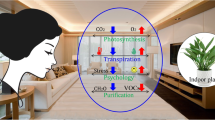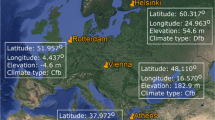Abstract
The present study carried out assessments regarding thermal sensations under different weather conditions in three urban areas in Cuiabá, Brazil, a Tropical Savannah climate (Aw) region. Thermal acceptability by means of thermal sensation votes (TSV) was addressed based on the estimation of the Universal Thermal Climate Index (UTCI) values. Important issues related to clothing thermal insulation (Icl), the effect of gender on thermal sensation, and implications of artificial conditioning (AC) systems are also evaluated. Micrometeorological variables were determined and 685 questionnaires were applied to evaluate individual pedestrian thermal preferences. The Icl observed in the Tropical climate was lower than that intrinsically inputted by the UTCI for Temperate climates. The local thermal comfort zone ranged between 21.5 and 28.5 °C, with both thresholds higher than those observed in studies conducted in Subtropical, Mediterranean, and Continental Temperate climates while the local hot thermal sensation categories were displaced at least 3 °C above than those for the aforementioned climates. The effect of gender on thermal sensation indicated that females are more sensitive to cold stress conditions than males, requiring higher Icl for temperatures below 28 °C. The physiological adaptation by continuous exposure to AC systems reduced the neutral temperature between AC and non-artificial conditioning system users (NAC) by 0.8 °C, with more intense differences in hot TSV ranges. This study reveals differences between stated TSV classes derived for other climates and those resulting from TSV declared by Savannah local residents, indicating that local thermal sensation scale for UTCI in an important key for environment planning.




Similar content being viewed by others
References
Álvares CA, Stape JL, Sentelhas PC, Gonçalves JLM, Sparovek G (2013) Köppen’s climate classification map for Brazil. Meteorologische Zeitschrift. Meteorol Z 22(6):711–728
ANSI/ASHRAE55. (2004). Thermal environmental conditions for human occupancy. ASHRAE, Standard. 2004. American National Standards Institute (ANSI), American Society of Heating, Refrigerating and Air Conditioning Engineers.
ASHRAE (1997) ASHRAE Handbook (SI), Fundamental, 1997. American Society of Heating, Refrigerating and Air-conditioning Engineers, Atlanta
Błażejczyk K, Broede P, Fiala D, Havenith G, Holmér I, Jendritzky G, Kampmann B, Kunert A (2010) Principles of the new universal thermal climate index and its application to bioclimatic research in European scale. Misc Geogr 14:91–102
Brasil. Ministério da Saúde. Secretaria de Vigilância em Saúde (2016) Vigitel Brasil 2016: Vigilância de fatores de risco e proteção para doenças crônicas por inquérito telefônico. Estimativas sobre frequência e distribuição sócio-demográfica de fatores de risco e proteção para doenças crônicas nas capitais dos 26 estados brasileiros e no Distrito Federal em 2016. Ministério da Saúde, Brasília
Busch J (1992) A Tale of Two Populations: thermal comfort in air-conditioned and naturally ventilated offices in Thailand. Energ Buildings 18(3):235–249
Callejas IJA, Nogueira MCJA, Biudes MS, Durante LC (2016) Seasonal variation of surface energy balance of a central Brazil city. Mercator 15:85–106
Callejas IJA, Durante LC, Nogueira MCJA (2013) Mapeamento da sensação térmica em ambiente urbano a céu aberto em clima tropical continental. XII ENCAC – Encontro Nacional do Ambiente Construído 1:1–8
Campelo Júnior JH, Priante Filho N, Caseiro FT (1991) Caracterização macroclimática de Cuiabá. III Encontro Nacional de Estudos sobre o Meio Ambiente, Londrina
De Dear RJ, Brager GS (1998) Developing an adaptive model of thermal comfort and preference. ASHRAE Trans 67:104–145
Dowdy S, Wearden S, Chilko D (2004) Statistics for research, 3rd edn. John Wiley & Sons, New Jersey
Fanger PO (1972) Thermal comfort: analysis and application in environment engineering. McGraw Hill, New York
Fiala D, Lomas KJ, Stohrer M (1999) A computer model of human thermoregulation for a wide range of environmental conditions: the passive system. J Appl Physiol 87:1957–1972
Havenith G, Fiala D, Blazejczyk K, Richards M, Bröde P, Holmér I (2012) The UTCI clothing model. Int J Biometeorol 56(3):461–480
Höppe P (1999) The physiological equivalent temperature – a universal index for the biometeorological assessment of the thermal environment. Int J Biometeorol 43(199):71–75
Huang J, Zhou C, Zhuo Y, Xu L, Jiang Y (2016) Outdoor thermal environments and activities in open space: an experiment study in humid subtropical climates. Build Environ 103:238–249
IBGE – Instituto Brasileiro de Geografia e Estatística. (2016). Resultados do Censo 2015. Available at http://www.ibge.gov.br/censo2015, on 20.06. 2016.
Instytut Geografii I Przestrzennego Zagospodarowania - PAN. (2018). BioKlima - universal tool for bioclimatic and thermophysiological studies. Avaliabe at https://www.igipz.pan.pl/Bioklima-zgik.html, on 05.05.2018.
ISO 10551. (1995). Ergonomics of the thermal environments – assessment of the influence of the thermal environment using subjective judgment scales. International Standards Organization.
ISO 7726. (1998). Ergonomics of the thermal environments: instruments and methods for measuring physical quantities. International Standards Organization.
ISO 7730. (2005). Ergonomics of the thermal environment – analytical determination and interpretation of thermal comfort using calculation of the PMV and PPD indices and local thermal comfort criteria. International Standards Organization.
ISO 8996. (2004). Ergonomics-determination of metabolic heat production. International Standards Organization.
ISO 9920. (2007). Ergonomics of the thermal environment—estimation of thermal insulation and water vapour resistance of a clothing ensemble. International Standards Organization.
Karjalainen S (2007) Gender differences in thermal comfort and use of thermostats in everyday thermal environments. Build Environ 42:594–603
Khrit NG, Alghoul MA, Sopian K, Lahimer AA, Elayeb OK (2017) Assessing the accuracy of globe thermometer method in predicting outdoor mean radiant temperature under malaysia tropical microclimate. E3S Web of Conferences, 23: 01006. https://doi.org/10.1051/e3sconf/20172301006
Krüger EL, Drach P, Bröde P (2015) Implications of air-conditioning use on thermal perception in open spaces: a field study in downtown Rio de Janeiro. Build Environ 94:417–425
Krüger EL, Drach P, Bröde P (2016) Outdoor comfort study in Rio de Janeiro: site-related context effects on reported thermal sensation. Int J Biometeorol 61:463–475
Krüger EL, Givoni B, Rossi FA (2010) Outdoor comfort study in Curitiba, Brazil: effects of gender, Body weight and age on the thermal preference. In: In: Proceedings of the Conference Adapting to change: new thinking on comfort. Network for Comfort and Energy Use in Buildings, London, 12 pp
Krüger EL, Tamura CA (2018) Effects of a heat wave on short-time acclimatization during experiments supported by a climate chamber. Ambiente Construído 18:491–501
Lai D, Guo D, Hou Y, Lin C, Chen Q (2014) Studies of outdoor thermal comfort in northern China. Build Environ 77:110–118
Lucchese JR, Mikuri LP, Freitas NVS, Andreasi WA (2016) Application of selected indices on outdoor thermal comfort assessment in Midwest Brazil. International Journal of Energy and Environment (IJEE) 7:291–302
Machado NG, Biudes MS, Querino CAS, Danelichen VHM, Velasque MCS (2015) Seasonal and Interannual Pattern of Meteorological Variables in Cuiabá, Mato Grosso State, Brazil. Rev Bras Geofis 33(3)
Meyer JP, Seaman MA (2014) A comparison of the exact Kruskal-Wallis distribution to asymptotic approximations for all sample sizes up to 105. J Exp Educ 81(2)
Pantavou K, Santamouris M, Asimakopoulos D, Theoharatos G (2014) Empirical calibration of thermal indices in an urban outdoor Mediterranean environment. Build Environ 80:283–292
Pantavou K, Theoharatos G, Santamouris M, Asimakopoulos D (2013) Outdoor thermal sensation of pedestrians in a Mediterranean climate and a comparison with UTCI. Build Environ 66:82–95
Pappenberger F, Jendritzky G, Staiger H, Dutra E, Di Giuseppe F, Richardson DS, Cloke HL (2015) Global forecasting of thermal health hazards: the skill of probabilistic predictions of the Universal Thermal Climate Index (UTCI). Int J Biometeorol 59(3):311–323
Peel MC, Finlayson BL, Mcmahon TA (2007) Updated world Köppen-Geiger climate classification map. Hydrol Earth Syst Sci 11:1633–1644
Rossi FA, Krüger EL, Bröde P (2012) Definition of thermal comfort and discomfort ranges for open spaces in Curitiba, PR, with the UCTI index. Ambiente Construído 12:41–59
Thach TQ, Zheng Q, Lai PC, Wong PY, Chau YK, Jahn HJ (2015) Assessing spatial associations between thermal stress and mortality in Hong Kong: A small-area ecological study. Sci Total Environ 502:666–672
United Nation (2018) Department of Economic and Social Affairs, Population Division (2018). In: World Urbanization Prospects: The 2018 Revision. Edition, Online
World Health Organization. (1995). Physical status: the use and interpretation of anthropometry. Report of a WHO Expert Committee. WHO Technical Report Series No. 854. World Health Organization, Geneva. Avaliable at http://apps.who.int/iris/bitstream/10665/37003/1/WHO_TRS_854.pdf, on 16.06.2016.
Zuur AF, Leno EN, Walker NJ, Saveliev AA, Smith GM (2009) Things are not always linear; additive modelling. In: Zuur AF, Leno EN, Walker NJ, Saveliev AA, Smith GM (eds) Mixed effects models and extensions in ecology with R. Springer, New York, pp 35–69
Funding
This work was financially supported by the Research Support Foundation of Mato Grosso, Brazil (FAPEMAT N. 0534180/2016).
Author information
Authors and Affiliations
Corresponding author
Additional information
Publisher’s note
Springer Nature remains neutral with regard to jurisdictional claims in published maps and institutional affiliations.
Rights and permissions
About this article
Cite this article
de Arêa Leão Borges, V.C., Callejas, I.J.A. & Durante, L.C. Thermal sensation in outdoor urban spaces: a study in a Tropical Savannah climate, Brazil. Int J Biometeorol 64, 533–545 (2020). https://doi.org/10.1007/s00484-019-01830-x
Received:
Revised:
Accepted:
Published:
Issue Date:
DOI: https://doi.org/10.1007/s00484-019-01830-x




